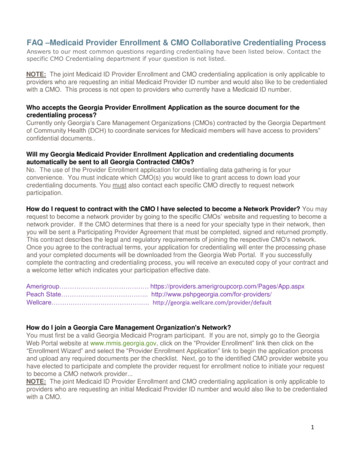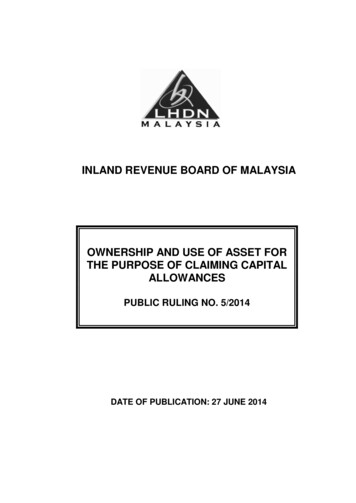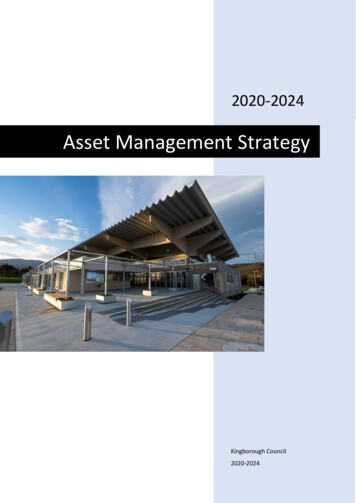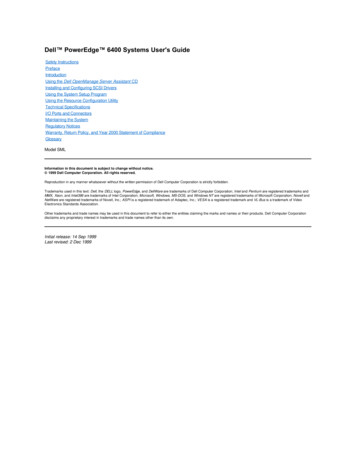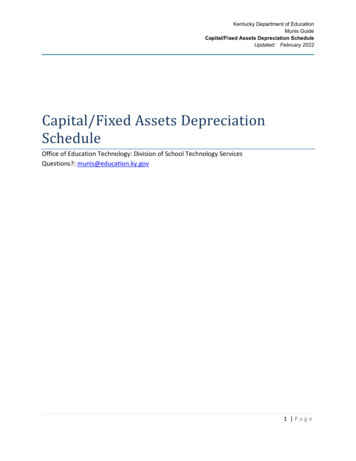
Transcription
1990 VALUATION ACTUARYSYMPOSIUM PROCEEDINGSSession 10Panel: CMO and Other Asset ProjectionsRandall Lee BoushekDavid A. Hall479
480
CMO AND OTHER ASSET PROJECTIONSMR. RANDALL LEE BOUSHEK: I will be one of two speakers on the panel for thissession. By way of introduction, I am an actuary with Lutheran Brotherhood, which is an 8 billion fraternal benefit society headquartered in Minneapolis. For more than threeyears I have been involved in the investment operations of Lutheran Brotherhood asmanager of the mortgage-backed-security (MBS) and derivative-security portfolios. As such,I have responsibility for, among other things, the analysis, selection and trading of securitiesin our collateralized-mortgage-obligation (CMO) portfolio. I also wear the title of managerof investment research and technology. My colleague on the panel is David Hall. Daveis an actuary with the Hartford Life Insurance Companies, and he too is involved in theinvestment operations of his firm as director of portfolios and asset/liability management.The format that we're going to use for our panel discussion is perhaps a little different thenwhat may be typical for such sessions. Because this is intended to be essentially a teachingsession, we thought we might be able to develop a more integrated and interesting approachby alternating our remarks rather than by each droning on uninterrupted. We hope we'llbe able to accomplish this without tripping over each other both literally and figuratively.481
1990 SYMPOSIUM FOR THE VALUATION ACTUARYOur topic is particularly timely. I concur with David Gardner's comments at the LuncheonSession that MBSs may well become the investment vehicle of choice for life companies inthe 1990s. MBSs -- a generic term that by way of definition includes any investment vehicleultimately supported by residential mortgage loans -- are delightfully complex investmentsthat offer diversity, opportunity and risk to investment managers, and guaranteed migrainesto accountants and actuaries. For a number of companies, MBSs in general, and CMOsin particular, already constitute a significant and increasing portion of their investmentportfolios. At Lutheran Brotherhood, approximately one-third of our life company assetsare invested in MBSs, primarily in about 150 CMOs, and approximately one-half of our netcash flow is applied to CMO purchases. Based on my conversations with Dave, I believethat both of these percentages are somewhat higher at the Hartford Life Companies. Itwould not surprise me at all to see companies with even higher levels of current exposure,or to see the life insurance industry in general increase its investment exposure to CMOssignificantly through the next several years.Before we dive into our agenda for this session, there are two prefacing comments that Iwould like to make, both of them in the nature of what we are not going to try to do. Thefirst thing we are not going to try to do is to turn you all into CMO gurus. There is aconsiderable segment of the investment profession that does not yet fully understand CMOs.Every investment conference that I've ever attended invariably has sessions on CMOs that482
CMO AND OTHER ASSET PROJECTIONSinvariably involve a multitude of charts and graphs that invariably evolve into very technicaldiscussions. We specifically want to try to avoid that with you. Our primary goal for thissession is ultimately to discuss the challenges and issues involved in modeling CMOs forasset/liability management purposes. We are going to assume no prior knowledge of MBSson your part, and thus we need to build a certain base of understanding about them beforewe can begin to talk about modeling them. However, we plan to keep this discussion veryelementary.The second comment is that we are not going to discuss specific software packages for acouple of reasons.First, we do not want to be providing commercial air time for anyparticular package or vendor. Second, and perhaps more important, we do not want toslight any firm or individual or package that we are not familiar with, or that may or maynot be well-suited to your particular needs. We obviously have our own experiences andopinions on software, but we'd like to reserve our comments on this for individualdiscussions after this session.With that said, we can discuss the agenda that we plan to follow for this session. CMOsare essentially financially engineered creations. As such, they are at their core nothingmore than a contrived but uncertain series of cash flows. In order for us to understand theengineering and how to model it, we need to start with an understanding of the raw483
1990 SYMPOSIUM FOR THE VALUATION ACTUARYmaterial -- MBS cash flows -- and the primary determinant of that raw material -- theprepayment function. Consequently, Dave is going to begin this session with a discussionof the prepayment function. Following that, I'll spend some time talking about variationsin CMO structures. There's no such thing as a generic CMO, and it's important that youunderstand just how much one CMO might differ from the next. After that we'll bothprovide brief comments on what we see as trends in the CMO market, which may ultimatelyimpact you. Finally, we'll take turns giving you our perspectives on cash-flow modeling forCMOs.Before I turn the floor over to Dave, I would like to address a very basic question that Ioften get when I talk about CMOs, namely, "Where do CMOs come from?" To answerthis, I'd like you to refer to Chart 1. We're going to read this diagram from top to bottomand from left to right.At the upper left-hand corner are homeowners.We arehomeowners or prospective homeowners who need to take out mortgages in order topurchase our homes.Those mortgages are provided variously by conlmercial banks,mortgage bankers, thrifts, or other types of financial institutions, which are depicted in theupper right-hand corner. These institutions package a number of such loans with othershaving similar characteristics and sell them to one of several governmentalorquasi-governmental agencies, indicated in the middle of the diagram. These agencies goby the acronyms G N M A (Government National Mortgage Association), FNMA (Federal484
CHART 1EVOLUTION OF A CMOBank, Thrift,Mortgage BankerHomeownersIi FI I-I dllIIAgencyInvestorsCMO Trust
1990 SYMPOSIUM FOR THE VALUATION ACTUARYNational Mortgage Association), and FHLMC (Federal Home Loan Mortgage Corporation),and exist for the sole purpose of buying loan packages from primary lenders and therebyadding capacity to the residential lending market. The agencies combine several packagesof loans with similar characteristics into something called a pool.Prior to 1983,proportionate interests in individual pools were sold directly to investors in the lowerright-hand corner of the diagram as mortgage pass-throughs. Pass-through issuance did notterminate in 1983, and investors still can and do acquire newly issued pass-through pools.However, since 1983 the generic entity located in the lower left-hand corner of Chart 1 -the CMO trust or special purpose corporation (SPC) -- has devoured the lion's share ofnew pass-through issuance, as well as an increasing share of outstanding pools. CMOs werefirst originated in 1983 by a few homebuilders and thrifts. The volume of originations grewslowly and steadily until 1986 and 1987, when the advent of the trust form of a CMO, andin particular something called REMIC (real estate mortgage investment conduit) legislation,gave it a tremendous boost.In a nutshell, REMIC legislation simplified the tax andregulatory aspects of CMOs and increased their appeal and availability to a significantnumber of investors.From that point the market literally exploded with growth.I'vedepicted the CMO trust or SPC in Chart 1 as a pair of scissors in a box. A CMO is reallynothing more than a shell within which cash flows from various agency pools are sliced anddiced and rerouted to investors.486
CMO AND OTHER ASSET PROJECTIONSMR. DAVID A. HALL: I suppose this means that a CMO is effectively a Veg-o-matic formortgages. That is not a bad analogy.My first topic is the prepayment function. I have some good news and some bad news.The good news is that there exists well over a quarter-century of data on prepayments thatwe can evaluate in attempting to model prepayment behavior. The bad news is that mostof those data are obsolete and irrelevant. The fact is that no one has ever been successfulat consistently and accurately forecasting prepayment rates for mortgage securities. But thatis not necessarily the bad news. In fact, prepayment uncertainty is one of the fundamentalfactors upon which the entire CMO market has developed. Since prepayments are noteffectively a diverslfiable risk (as is also true of call risk), CMO structures have beencreated to reallocate this risk exposure. It is because of the uncertainty in prepayments thatinvestors are paid to accept this risk. It is because this risk premium can be significant thatinsurers have been willing to be paid to accept this risk. And it is because insurers haveaccepted this risk that most of you are here, presumably hoping to glean some informationto help you analyze how that risk integrates or disintegrates with your asset-liabilitystructure. In this discussion of prepayment models, I will put forward several historicalmodels, discuss the limitations of those models, mention some of the factors that influenceprepayments, and highlight some evidence which supports my premise that prepaymentsmust be regarded as a truly random variable.487
1990 SYMPOSIUM FOR THE VALUATION ACTUARYLet us begin by considering some of the sources of mortgage prepayments.The mostobvious source is when a homeowner sells his property. In most cases, that generates theprepayment of his mortgage.(Some mortgages are assumable by the purchaser, and if thisright is exercised, the sale would not generate a prepayment.) A default (in the context offederal agency mortgage pass-throughs) generates a prepayment, because the agency, usuallyFNMA, FHLMC, or G N M A pays off the investor in the event of a mortgage default.Casualty losses may cause prepayments. If a home burns down, the homeowner (or hisinsurer) will pay off the mortgage. Accelerated payments are a type of prepayment. Thisinfluence may be the least understood aspect of prepayment activity, but it is probably alsovery commonplace right now. What I am thinking of is the concept of tucking a little extrainto your mortgage payment each month to attempt to pay down the balance a little fasterthan scheduled; that activity generates a partial prepayment each month.The last andperhaps most important source is refinancing. This derives from the homeowner's optionto put the mortgage back to the issuer, presumably to refinance it at a more attractive rate.Prepayments are likely to be "economical" from the standpoint of the homeowner.However, it is important to understand that many prepayments may be "noneconomicar'from the perspective of the lender or investor. It may be that a mortgage is refinanced ata time when it is not to the detriment of the investor. For example, if a mortgage holderwishes to "take out" some additional equity, it may be more convenient (or even more488
CMO AND OTHER ASSET PROJECTIONSinexpensive) to do that through a new first mortgage loan rather than by layering on asecond mortgage. So a prepayment is not necessarily happening at a time which is againstthe economic interest of the ultimate investor.Let us now consider one of the earliest models of prepayment activity, the Federal HousingAdministration (FHA) Experience tables. Chart 2 shows prepayments from two different(although overlapping) time periods. They are based on 1957-81 and 1970-84 FHAexperience as gathered by the U.S. Department of Housing and Urban Development. Thegraphs relate the annual prepayment rate (along the Y axis) to the seasoning (or age) ofa mortgage (along the X axis). A prepayment rate is the percentage of mortgages thatwere outstanding at the beginning of a year that are not outstanding at the end of that year.As you can see, by the end of the first year approximately 2% of the mortgages wereprepaid; by the end of the second year an additional 4% or more prepaid. This uptickobviously results from the selection factor. New mortgage holders typically do not selltheir homes within months of buying these homes, and so there is an initial period duringwhich prepayment rates tend to gradually increase (called the seasoning period). In theseexamples, annual prepayment rates increase through roughly seven years, then declinegradually until year 20, after which a more dramatic increase appears. This late increaseprobably represents the "nuisance factor." By this I mean that balances get to be so smallthat they are either refinanced to take out additional equity, or just paid off to eliminate489
CHART 2PREPAYMENT MODELSFHA EXPERIENCEAnnual PrepaymentRate16%14% 12% -io% -/8%6%4%2%O%I05JII10I15Seasoning1957-81 FHASource: US Dept. of HUD2025(yrs.). 1 9 7 0 - 8 4FHA
CMO AND OTHER ASSET PROJECTIONSthem. Note also that the later experience table seasons faster; that is presumably becausethat experience captures the period from 1981 to 1984, which was a period of prettyradically declining rates, dropping from highs in the upper teens all the way down to thelower teens. This period must have included a lot of rate-driven refinancing activity that waslargely insensitive to seasoning influences. For example, if you had an 18% mortgage lastyear, and you are now able to refinance it at 14%, does it really matter how long you'vebeen in the home? A lot of people exercised that opportunity pretty quickly.What are the drawbacks of using this as a prepayment model? First, since it is based solelyon the age of the mortgage, it fails to capture any other factors as determinants ofprepayment activity. It averages many different coupons, which refer to the interest ratespaid on the mortgage. The observed mortgages probably have underlying interest ratesfrom 4% to 18%. Also, the table is based only on assumable FI-IA mortgages, it spansmany different economic environments, and many of the measured trends may now beobsolete.What other factors should we be considering in modeling prepayments? Seasoning clearlyis important and is one factor that most models do capture, especially reflecting thepreliminary "select period."Seasonality is also a factor.By seasonality I refer to thephenomenon that prepayment activity is usually higher in the summer than it is in the491
1990 SYMPOSIUM FOR THE VALUATION ACTUARYwinter. In some CMO structures that is fairly inconsequential, but in some structures it canbe very consequential.Changes in market interest rates are a primary determinant ofactivity, not only as it relates to refinancing activity, but also in the sense that when ratesare low, housing turnover (and the resulting prepayment activity) has tended to be higher.There is also a product selection factor. New home buyers today have a wide selection ofmortgage alternatives from which to choose. These include traditional 30-year fixed-ratemortgages as well as 15-year mortgages, seven-year balloon mortgages, and a wide varietyof adjustable rate mortgages. It is likely that home buyers who expect to be moving fairlyquickly will not opt to take out a 30-year fixed-rate loan. Instead, they may opt for anadjustable rate alternative, or perhaps even a seven-year balloon mortgage, since the needto refinance the mortgage in seven years may not be seen as too onerous if they do notexpect to remain in that home for a full seven years. So product selection by the borroweris clearly an influential factor. This is one of the main reasons why much of the historicaldata are obsolete, because much of the data come from a time when 30-year fixed-ratemortgages were virtually "the only game in town.""Burnout" is another factor to consider. In any pool of mortgages there are likely to besome mortgage holders who are very sensitive to their refinancing opportunities, some whoare less sensitive, and some who just fail to catch on. With a brand new pool, you willusually notice that the first opportunity to refinance is greeted with a burst of prepayment492
CMO AND OTHER ASSET PROJECTIONSactivity, as those who are very sensitive to their refinancing opportunities take quickadvantage. Prepayment activity will often remain high for some period of time after that,as those who failed to refinance right away gradually get around to it. But there verydefinitely is a burnout, or a period after which prepayment activity seems insensitive torefinancing opportunities.Believe it or not, there are still some GNMA 18% loansoutstanding today, meaning that there are still some people who are paying 18.5% on theirfixed-rate mortgages.I said earlier that all prepayment decisions made by mortgageholders are economic in their own frame of reference. I am not sure, though, that theirdecision not to prepay is always economic.Geography influences prepayments. California loans have typically prepaid faster. Certainly,any area of the country where economic activity or housing turnover is high will generatefaster prepayment activity. Demographics will influence prepayments. Homeowners whoare in one economic strata may have very different prepayment activity than those inanother.So dearly, there are a wide variety of factors to be considered in modelingprepayments.As it turns out, the FHA experience table is not used very much, not only because of someof the limitations that I have discussed, but also because it is a complicated, nonlinearscale. The most prevalent model is the Public Securities Association (PSA) Model. The493
1990 SYMPOSIUM FOR THE VALUATION ACTUARYPSA is an association which promulgates standards for quoting yields and settlementprocedures for publicly traded securities. Chart 3 shows the PSA Model compared to thetwo F H A tables.It consists of a 2.5 year seasoning period during which (annualized)prepayment rates increase linearly each month from .2% to 6%. This is followed by a level6% prepayment rate from month 30 to the end of the mortgage term. This is the modelthat is typically used as a basis for quoting yields and projecting prepayment profiles onCMO securities and has been the standard since about 1985. PSA did want to capture thatinitial seasoning period, because for shorter tranches of mortgage securities, this seasoninginfluence can be very critical to the yield and average maturity calculation. It was felt thata standard was needed that would capture this influence, but that was also simple enoughthat it could be easily understood.Usually prepayment rates are quoted as a percentage of the PSA model.The rates inChart 3 represent 100% of PSA model. For 200% of the PSA model, one would doubleall the rates, and in fact one can use any percentage of PSA from 0% up to very highmultiples. For most mortgage securities today, quoted speeds would tend to be from a lowin the 50% to 75% PSA range for lower-coupon GNMAs, up to 500% to 600% PSA forhigher-coupon conventional mortgages.494
CHART 3PREPAYMENT MODELSFHA EXPERIENCE VS. PSA MODELAnnual PrepaymentRate16%14% 12% .3 0 Months 6%. . ". . . .". . .e. "*. .4% -i .2%.0%0510152025Seasoning (yrs.). 1 9 5 7 - 8 1FHA. 1 9 7 0 - 8 4FHA PSA Model
1990 SYMPOSIUM FOR THE VALUATION ACTUARYWhile the PSA model is usually regarded as a benchmark, I would like to illustrate thecurrent level of uncertainty in prepayment speeds. Chart 4 shows the current median, high,and low mortgage prepayment speed projections for ten major Wall Street broker-dealerfirms. These projections are for the most recent production FNMA and FHLMC 30-yearmortgages. The prepayment rates are from about 130% to 140% of PSA for the deepestdiscount mortgages, and they increase as the mortgage coupon rises, as one would expect.The top line shows the highest prepayment rate projected by any of the ten firms, and thebottom line shows the slowest speed. Not much variation exists for the discount securities,where there is only about plus or minus 10% in expectations of prepayments between thehigh range and the low range relative to the median. Moving out to 11% coupons, we finda much wider range of plus or minus 25% relative to the median speed. These are basedon models that are developed by firms that obviously have a lot of manpower andhorsepower to devote to modeling prepayment activity, and yet they are obviously comingup with widely varying projections of what prepayment rates will be experienced.Ifdifferent Wall Street firms arrive at such a wide variety of answers, it is unlikely that we asactuaries are going to do a much more refined job. I think you should resign yourself tothe concept that there is an element here that is going to have to be regarded as random,an element that you are unlikely to be able to capture, and thus you should be technically(and emotionally) equipped to deal with significant variability in mortgage prepayments.496
CHART 4DEALERS' PREPAYMENT ESTIMATESFNMA/FHLMC AS OF 10/4/90% of PSA M o d e l400%f300%200%100%0%8%III8.5%9%9.5%I10 0/0III10-5%11%11-5%Mortgage Net Coupon LowSource: Bloomberg Financial MarketstAverage H i g h12%
1990 SYMPOSIUM FOR THE VALUATION ACTUARYI want to mention one more aspect of prepayment variability, a phenomenon called"idiosyncratic prepayment risk."This is a term that I believe was first coined by themortgage research analysts at Morgan Stanley & Co.It refers to the variations inprepayment speeds which are commonly observed among different pools of otherwisesimilar collateral. Chart 5 illustrates data for three different FHLMC deals that were allissued within a two-month period from November 1988 to January 1989. Two of the dealsare a billion dollars in size, and the other is a half billion dollars in size. The weightedaverage coupon (WAC) that is paid by the mortgage holder, is very close to 10.2% for eachdeal. The weighted average final maturity (WAM) of the collateral is also very similaramong the deals, about 27.5 years currently. Let us look at the last 12 months of actualprepayment experience. Expressed as a percentage of the PSA model, these three dealsprepaid at 116% of PSA, 180% of PSA, and 130%. Thus we observe wide variations ofprepayment experience on very large aggregations of seemingly similar collateral. Theimplication of this is that even if one could accurately model the prepayment behavior ofthe market in aggregate, one should still expect to find significant variability from deal todeal, even for very sizable deals as demonstrated by this example.How would I sum up this discussion? Prepayments can be modeled, but a meaningfulmodel must accommodate a significant degree of seemingly random variability. To be498
CMO AND OTHER ASSET PROJECTIONSCHART 5IDIOSYNCRATIC PREPAYMENT RISKFHLMC 22FHLMC 21FHLMC 30Issued:11/8812/881/89Size: 1 Bil. 0.5 Bil. 1 Bil.WAC:10.205 %10.222%10.159%WAM:27.5 yrs.27.7 yrs.27.3 yrs.Prepaid:116% PSA180% PSA130% PSA499
1990 SYMPOSIUM FOR THE VALUATION ACTUARYcomfortable with the analysis of CMO tranches, one must accept that a level of prepaymentuncertainty is inevitable.MR. BOUSHEK:I'm going to talk a little bit about variations in CMO design, which Isubtitle as "All CMOs are Not Created Equally." I intend to cover this section in threepieces, beginning with a graphical look at an early, simple CMO, followed by a discussionof differences in collateral and finally a discussion of differences in structure.Please refer to Chart 6. What I have constructed here is a very simple 3-tranche CMO.In CMO-speak, a tranche is simply one slice of cash flows. The graph on the left showsyear-by-year the amount of principal that's paid off on an MBS. Ignoring the differentshadings for now, this is the pattern of the return of principal for a collection ofpass-through pools priced at 0% PSA, i.e., assuming that all homeowners in all the poolspay their loans exactly on schedule. The graph on the right, which uses a different scale,shows year-by-year the remaining amount of principal outstanding that generates interestfor the next period. The shadings in the graphs represent the simple sequential tranchingof the principal cash flows within this pure vanilla CMO. In this particular case, the first40% of total principal cash flows are assigned to one class of investors, the next 35% toanother class (us), and the final 25% to a third class. A key underlying premise of CMOsis that the sum of the parts have to add up to the whole, and that should be evident in this500
1990 SYMPOSIUM FOR THE VALUATION ACTUARYexample. In the left-hand graph you can see that if all these homeowners pay their loansoff exactly on schedule, our second tranche will start paying down in year 22 and willcontinue until we get that last little sliver in year 28. In the right-hand graph you can seethat the amount of principal that we have left outstanding that will generate interest for usremains level for 22 years and then declines as we begin to receive our repayments ofprincipal.Now, instead of assuming 0% PSA prepayments, what if I assume that prepayments will bereceived at 100% of the PSA model? In other words, what if aggregate loan repaymentsgrade into an annualized rate of 6% of outstanding principal by the thirtieth month afterorigination of the loans and remain at that rate thereafter? The radically different shapeto our expected cash flows is shown in Chart 7. Again, if we ignore the shadings for amoment, you can see the dramatic impact of this assumption on the aggregate principalcash flows and remaining balances of the underlying loans. Much more principal is paidup front, and much less principal remains outstanding. If you focus now on what happensto our 35% of those cash flows, you can see that we have shifted from receiving principalcash flows in years 22 through 28 to now receiving our principal back in years nine through18. For this example, I have assumed that our CMO was created out of GNMA 9.5%pools, which are a collection of Veterans Administration (VA)/FHA 10% 30-year loans.502
CMO AND OTHER ASSET PROJECTIONSCHART 73-TRANCHE CMO100% PSAPrincipal Repayment: ".: :::::. ' - . :::.::':: - ::::.: : :f ::::::::::::::::::::::::::::::: .: ':' .:.:': --::1:::::::::::::.": :.:: : : : : ::::::::: ::':::: ::: : : : : ::: :':':- .'. -':.::: ::::::::::.:-::: - : : : :: : ":: : :'::.: :.-::-:.:'i'::?:"' " :;::. : .! i ::.i:: i: : : : : !. i: ! t.i:. . :. : ::: .::: ::: ::::. : :!i. ::.::i:!: :!: .%: : y :i:!. .: i i . !:X:: ? -: .; i:: :ii! !i . :! : . : : !.: .::! !:. :::.:?- . :: -':, ;:- ?.:::'.: : ,-'-:-:-i- ::.: : : . -' ': .%'.," !::} ' -.: -': :':' ":'."."-. :.' . .: N : * . : .: " N: ::N'i: .:::.? ::::::- .:.,::.::::: :z::::: ::::,.' -! .': : y !.::;:. : -ii .;./.[ ,:. : : .'.: :.:: .': .-.: . ). :::::.: ::: . .:: : : ::: :.,. . : .'.'.:'.". . . . . }: :-'-::. .::':::.'-.!. " ,:':::::::::k '. . :: ': :::: . :".:::'::: :5 " :::.: . . ' ":':"" :' . ::.,.:x:'. : 2:: ::::.::::: :.[ .i . .-' . : , .'. - -. '.,,. .: . :-. '-.'.:,. : :. . .:.II. ;;- BHH I IHI i BBIHI B .: . I - : , ! : ' .:": ' ; : : ' : ::.': .:: ;.::' : :: i 3. ;:.:::'- : . . . I ::':. ' ::.::::' .-". -':-. -:::-. --',.: '-:.-:-- - -:.-:-::.: .: - -:- -x.:-::-::::-:. : -x-:. .'.:. . " :: '-' :: : ::]: .;.' .i- .". . - . ':::i .-'. : . - . -- .-' .- . ::: .::-.i::::;i .: ;::.-:-:-,,: :. ;:::--::::: :'" ."."i .". oPrincipal Remaining I00i'::-':':: ':x:b':::': ' .'-. .::. :-. '.::: ": ,. ".::'-.:#.:,:".':.,:: ". --. . . . ., ---:. 80 6O 40. ., . , . . . . ,.- .:. . ,.,. , . :: . . :: :,.:. . x-: . -i. .-: ::::. .-,,x .- .o. o.,. . . ' -'. :, ] . :." . :- . . 20- -t. -. . /. . : :. ! ., . . -.,.-. : .- . Y.' ' :. A'. :.' .' -. --- . SO503.---:. .-
1990 SYMPOSIUM FOR THE VALUATION ACTUARYThis 100% PSA might be called our current best guess as to future prepayments for thistype of collateral.Finally, suppose that interest rates drop dramatically and we decide that 100% PSA is anunrealistic assumption. Believing that several homeowners might now be tempted to payoff their loans by refinancing at a lower interest rate, we decide that 400% of PSA is amore appropriate assumption. This means that by the thirtieth month after origination weexpect principal repayments to be coming in at an annualized rate of 24% of outstandingprincipal each month. In this case, the shape of our graphs change even more dramatically,as shown in Chart 8. Looking directly at our shaded tranche, we now expect to get ourprincipal back not in years 22 through 28, not in years nine through 18, but rather in yearsfour through seven.As complicated as they may seem, these few graphs show you what CMOs used to look likein the "good old days." This is the simplest, most pure vanilla form that a CMO can take.I'm not sure I could even illustrate with a set of graphs some of the more complex CMOscurrently available in the market. Regardless of the degree of complexity, however, onepoint should be clearly obvious from any graphical depiction of a CMO, namely, that thecash flows of a single CMO tranche cannot be considered or projected in a vacuum apartfrom the other tranches.504
CMO AND OTHERASSET PROJECTIONSCHART 83-TRANCHE CMO400% P S APrincipal Repayment 20 II :-: :::-:-: . .;:::-::' :;&; ::-.-.';:;:'i::'::::ii:i:;.: ;:!!;.: .:i:i . :::ii.;: ; .;-;'i:i'i :.':T:i::i:-::::::!:.: ;-:::i::ii' .; 'i ::;: ' .i';'i'. ":':':-i:i:i-:- ::.':::::.;:;:;:iT,::::: ::; 2.:: ! . ? i:"' ::::i . : .
I have responsibility for, among other things, the analysis, selection and trading of securities in our collateralized-mortgage-obligation (CMO) portfolio. . cash flow is applied to CMO purchases. Based on my conversations with Dave, I believe . FNMA (Federal 484 . CHART 1 EVOLUTION OF A CMO Homeowners Bank, Thrift, Mortgage Banker CMO .
